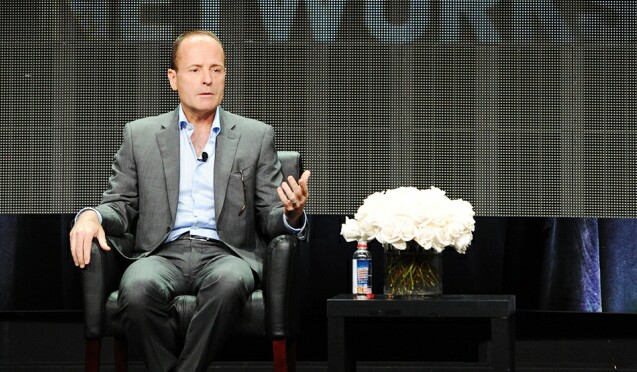TCA: FX's John Landgraf Explains the New World Order

Beverly Hills, CA – John Landgraf, CEO of FX Networks and FX Productions, never fails to super-charge the twice-yearly Television Critics Association tours – even though FX is often the last network to present its panels and Landgraf faces hundreds of reporters who have seen it all, heard it all and written it all during the previous two (or more) weeks. He does something no other network chief so consistently does during his TCA sessions – he identifies major issues facing the television business at the time and puts them in fresh context in a straightforward, no-nonsense manner.
This time it was “the elephant in the room at TCA,” as he called it, referring to the “massive transformation” or “disruption that the business is undergoing.” He was talking about the perils of Peak TV -- a term he coined during a TCA tour a couple of years ago. “For a while now, many of us could see that we were heading from an optimal number of shows to an unmanageable number of shows,” Landgraf noted. “In fairness, there is still more great TV and more diverse TV each year than the year before, and that’s certainly a good thing, but it doesn’t seem quite as special or at times as joyful within this paradox of choice and glut of oversupply the new marketplace has created.”
Landgraf then explained why, in his opinion, there is too much television and why this glut seems likely to continue on an indefinite basis. But rather than drill down, he went broad. “In my opinion, if we want to understand the roots of the underemployment and stagnant wage growth that has afflicted the U.S. economy and that underpins today’s uncertainty, anger and political polarization, we should look no further than the lack of market regulation that has over the past 40 years allowed one sector of our economy after another to be swallowed up by a single company or a tiny handful of giant oligarchs,” he said. “We are no longer just talking about utilities as monopolies, duopolies [or] triopolies. We are talking airlines, finance, most physical and online retail, Internet search, Internet advertising, user-generated video, social media, ride hailing, online payment and [much] more.
“These giant enterprises, which now represent a huge percentage of our total economy, are often very efficient and can at times actually be good for consumer innovation pricing,” he continued. “They are certainly good at facilitating ease of use, facilitating the theft of intellectual property, grinding the margins out of all kinds of brands, and eliminating smaller rivals; but, unfortunately, they have also rendered it almost impossible for mid-sized, regional, start up and family owned enterprises to succeed in most consumer markets and across many rural, smaller urban and interior regions of our country. And since local entrepreneurship has always been the engine of America's middle-class miracle, this new structure has crushed opportunity and wage growth for many U.S. families. The productivity of the American worker has more than doubled over the past 40 years while wage growth has hardly moved.”
He went on to offer “a Jonathan Swiftian parable for the Internet age,” noting that what he was about to say was not his own original idea, but that he couldn’t find the correct attribution. “A company starts a business that sells $100 bills for $90 each. Of course, $90 is very cheap for a $100 bill, and all you have to do to get this bargain is give your e-mail address and credit card number. So the new business quickly amasses billions of users and trillions of dollars in revenue, thus becoming the most valuable business on Earth while losing money. Why would investors extend seemingly infinite lines of credit to businesses which lose money while simultaneously devaluing businesses that are profitable? The answer is, those investors must believe the government has lost its ability or will to regulate monopolies, and therefore, the key determinate of a business’ current value is its progress towards achieving an unassailably dominant future position even if there are current losses rather than profits -- so scale has become the only absolutely essential measure of value in the current economy.”
Makes sense … but what has that got to do with the perils of Peak TV? “If you’ve been curious about why there’s more television being produced than you or anyone can possibly watch, understand that a good deal of that programming is being produced at a loss in the belief that it will drive a massive shift in the share of consumption which, in turn, will swamp existing competitors, ultimately driving a fundamental shift in market value,” Landgraf explained. “Even beyond television, which is our current focus in this room, we are all watching an epic battle unfold for who will control human attention, which is both a finite resource and the most economically valuable commodity on Earth, because who controls your attention controls the ability to monetize that attention. This is the root of the battle between Walmart and Amazon, between Facebook and Google and Apple, between Instagram and Snapchat, between Netflix and Amazon and the legacy television brands. It’s creating the exhilarating race to the top as seen in the competition to create ever higher quality television programs, but it is also creating a glut of content and the depressing race to the bottom in the dissemination of anger-provoking, false or misleading information and endless volumes of relative mediocrity in so many areas.”
Later responding to a reporter’s question about the impact of one or two companies dominating any business, Landgraf replied, “I think that’s Silicon Valley’s business strategy and operating model. There is ample evidence to demonstrate that Silicon Valley’s model is a ‘winner-take-all’ or ‘winner-take-most’ or a monopoly or duopoly structure. Silicon Valley’s model is to use platforms and algorithms and scale to essentially serve people what they need and to obviate the need for brands as much as possible and then to grind the margins out of brands.
“If you just talk philosophically about Silicon Valley’s future [version] of the world, it would be that Amazon would recommend to you and sell to you every major product you would need and brands would become less and less relevant,” he continued. “In that world it’s about scale. It’s about data. It’s about technology, AI algorithms, finance. It’s about being able to bring billions upon billions of dollars even at loss to bear on conquering markets. That’s a very stiff headwind for anybody who’s not in Silicon Valley and not on that side of that business model.”
Landgraf then suggested that FX+, a new streaming service that FX and Comcast had announced days earlier that is set to launch on September 5, will fortify FX Networks amid this harsh new reality. It will cost $5.99 a month, and the initial rollout will be in Comcast homes. FX is having conversations with every other MVPD, Landgraf said.
The new service will offer every episode from every season of many of FX’s original series, plus the simultaneous telecast of new episodes of current series as they premiere, but without commercial interruption. “For a while now, even as FX has enjoyed its best years ever, it has been obvious to us that we were going to have to considerably improve our strengths, diligently shore up our weaknesses and aggressively transform our consumer model in order to thrive well into the future,” Landgraf said.
“We are just going to have to pivot," he continued. "We are going to have to be better at serving up nonlinear content. This is where the ownership of the bulk of our programs and the depth and quality of FX’s original programming output over the last 15 years -- which is, I think it’s fair to say, unmatched by any other ad-supported network -- can become the source of unique strength and consumer value.”
There are complications involving current and future content FX has already sold or might sell to Hulu, Netflix and Amazon. “We still have work to do,” Landgraf admitted. “Even if you were a subscriber to Hulu and Amazon and Netflix, you still wouldn’t have the full set of content that’s on FX+, but a lot of the content that’s on FX+ will also simultaneously be on either Hulu or Amazon or Netflix, because we’re making a transition from a linear channel that licensed content and then sold all that content off to other people, and it’s just not an easy business pivot to do.”
Of course, even Landgraf agrees that the average home is not going to subscribe to unlimited streaming services, even as they continue to grow in number. “We’re talking about a very, very significant reordering of the structure of television,” he said. “I do think, by the way, that the relative stability of the MVPD system and the fact that FX still has three channels, in the aggregate 225 million paying subscribers, is a source of strength because we’re not saying we have to get to 35 million subscribers or however many HBO has. We’re layering a new subscriber business on top of an existing business.
“But the reality is that nonlinear consumption [with] subscriber fees is a growing industry, and we are, at best, ‘flat-ish’ inside the industry we’re in now,” he concluded. “So I think you’re seeing the beginning of a big trend, and I don’t think anybody knows for sure where that trend finally sorts out.”
Click on the social media tiles above or below to share this content with your friends and colleagues.
The opinions and points of view expressed in this commentary are exclusively those of the author and/or subject(s) and do not necessarily represent the views of MediaVillage.com/MyersBizNet, Inc. management or associated bloggers.


